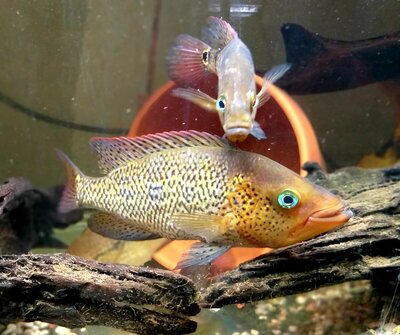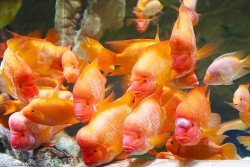Petenia splendida, the Bay snook cichlid from Central America

With its shining scales and impressive size,
Petenia splendida lives up to its splendida species name. This highly prized Central American cichlid is also known as the bay snook or Maya cichlid, referencing its restricted native range within inland waters of southern Mexico, Guatemala, and Belize. As one of the few extant members of its genus, Petenia splendida offers a rare window into the evolution and distribution of New World cichlids. Capable of reaching up to 16 inches long in the wild, its substantial adult size and predatory behaviors need to be accommodated in home aquariums. Yet with dedication to mimicking its native water conditions and providing adequate swimming space, P. splendida rewards its keeper with glimpses of its ancientconnections and reminders of how some of the most impressive fish thrive in modest, local forest streams.
Petenia splendida, the
Bay snook, is a species of cichlid from Mexico and northern Central America. It is important to local commercial fisheries. Inhabits lakes and lower river valleys. Prefers lower and middle reaches of rivers in the slower moving waters with soft substrate of sand and mud. Feeds on fish. The native range is Central America: Atlantic slope of Grijalva River to Usumacinta River (Mexico), Usumacinta River (Guatemala), and Belize.
You will need an enormous tank as this is a gigantic cichlid when mature. Aim for a system of at least 180 x 45 x 45cm/6' x 18" x 18" and equip the tank with a very powerful filter. Use heavy rocks and bogwood to prevent the fish rearranging the decor too much. The genus Petenia is monotypic, so this is the only species available. However, it does exist in at least two colour forms including a pinky-gold version. The fish shown here has doubled in size and started to turn a sort of peachy color.
Bay snook cichlids aren't particularly rare, but is still far from common in the hobby. Specialist dealers should be able to obtain this species relatively easily.

Petenia splendida cichlid Video
Petenia splendida species profile
Synonyms
Petenia splendida has no widely recognized synonyms.
Etymology
The genus name "Petenia" likely refers to Lake Petén Itzá in Guatemala, where the species can be found. The species name "splendida" derives from the Latin word for "splendid" or "gorgeous," which aptly describes the fish's striking appearance.
Classification
Petenia splendida belongs to the family Cichlidae within the order Perciformes. It is often classified in the subfamily Cichlasomatinae or Heroini tribe due to its cichlid classification.
Distribution
Petenia splendida is native to freshwater environments in Central America, primarily found in parts of Mexico, Belize, and Guatemala. It is particularly prevalent in Lake Petén Itzá and surrounding waters.
Habitat
This species inhabits various aquatic environments, including lakes, rivers, and streams. It is often found in areas with submerged vegetation and rocky structures that offer hiding spots and shelter.
Maximum Standard Length
Petenia splendida can reach a maximum standard length of about 14-16 inches (35-40 cm), making it a relatively large cichlid species.
Aquarium Size
For a single adult Petenia splendida, a spacious aquarium of at least 75 gallons is recommended. Larger tanks or outdoor ponds are preferable for accommodating their size and swimming habits.
Maintenance
To maintain Petenia splendida in captivity, provide ample hiding spots, a sandy substrate, and driftwood or rock formations to mimic its natural habitat. Regular water changes and filtration are essential to ensure water quality.
Water Conditions
Maintain water temperatures around 75-82°F (24-28°C) and a pH range of 6.5-8.0. The water should be moderately hard, with proper filtration to remove waste.
Diet
Petenia splendida is primarily carnivorous, with a diet consisting of live or frozen foods such as small fish, crustaceans, and insects. Providing a varied diet helps ensure their nutritional needs are met.
Behaviour and Compatibility
These cichlids can be territorial and aggressive, especially during breeding and when establishing their territory. They may not be suitable for community tanks and are best kept with larger, robust tankmates to minimize aggression.
Sexual Dimorphism
Sexual dimorphism in Petenia splendida can be challenging to discern. Males might exhibit slightly more intense coloration, but differences are generally subtle.
Reproduction
Breeding Petenia splendida can be complex. They are substrate spawners, and successful breeding often requires a separate breeding tank with suitable hiding spots. Both parents participate in guarding eggs and fry.
Endangered List
Petenia splendida is not listed as endangered.
 With its shining scales and impressive size, Petenia splendida lives up to its splendida species name. This highly prized Central American cichlid is also known as the bay snook or Maya cichlid, referencing its restricted native range within inland waters of southern Mexico, Guatemala, and Belize. As one of the few extant members of its genus, Petenia splendida offers a rare window into the evolution and distribution of New World cichlids. Capable of reaching up to 16 inches long in the wild, its substantial adult size and predatory behaviors need to be accommodated in home aquariums. Yet with dedication to mimicking its native water conditions and providing adequate swimming space, P. splendida rewards its keeper with glimpses of its ancientconnections and reminders of how some of the most impressive fish thrive in modest, local forest streams.
With its shining scales and impressive size, Petenia splendida lives up to its splendida species name. This highly prized Central American cichlid is also known as the bay snook or Maya cichlid, referencing its restricted native range within inland waters of southern Mexico, Guatemala, and Belize. As one of the few extant members of its genus, Petenia splendida offers a rare window into the evolution and distribution of New World cichlids. Capable of reaching up to 16 inches long in the wild, its substantial adult size and predatory behaviors need to be accommodated in home aquariums. Yet with dedication to mimicking its native water conditions and providing adequate swimming space, P. splendida rewards its keeper with glimpses of its ancientconnections and reminders of how some of the most impressive fish thrive in modest, local forest streams.



